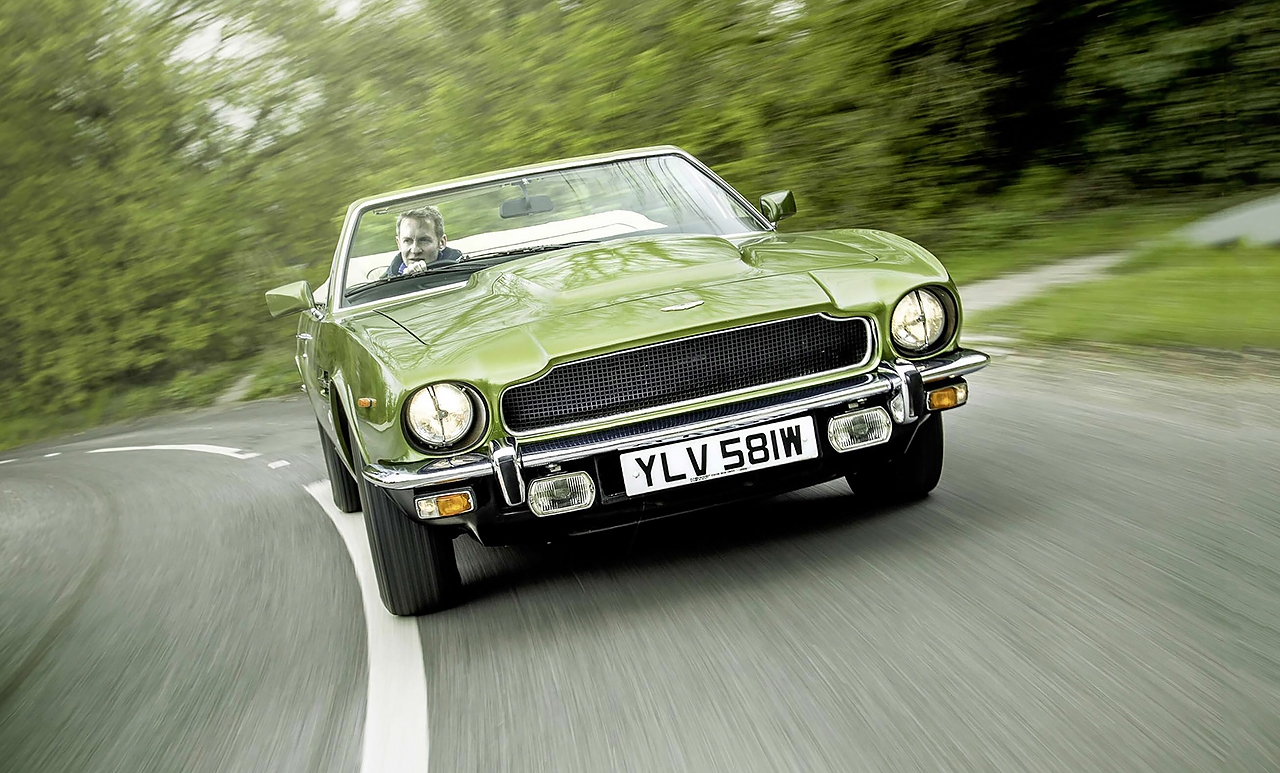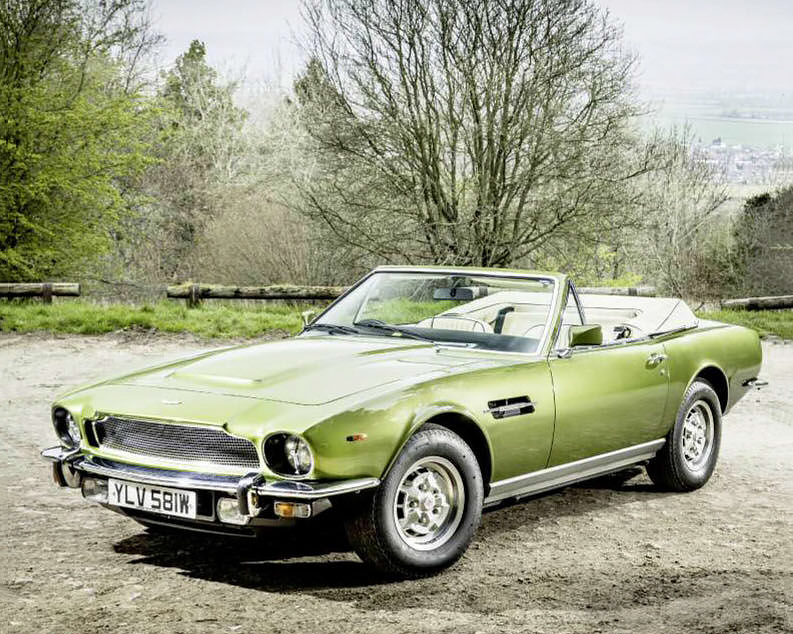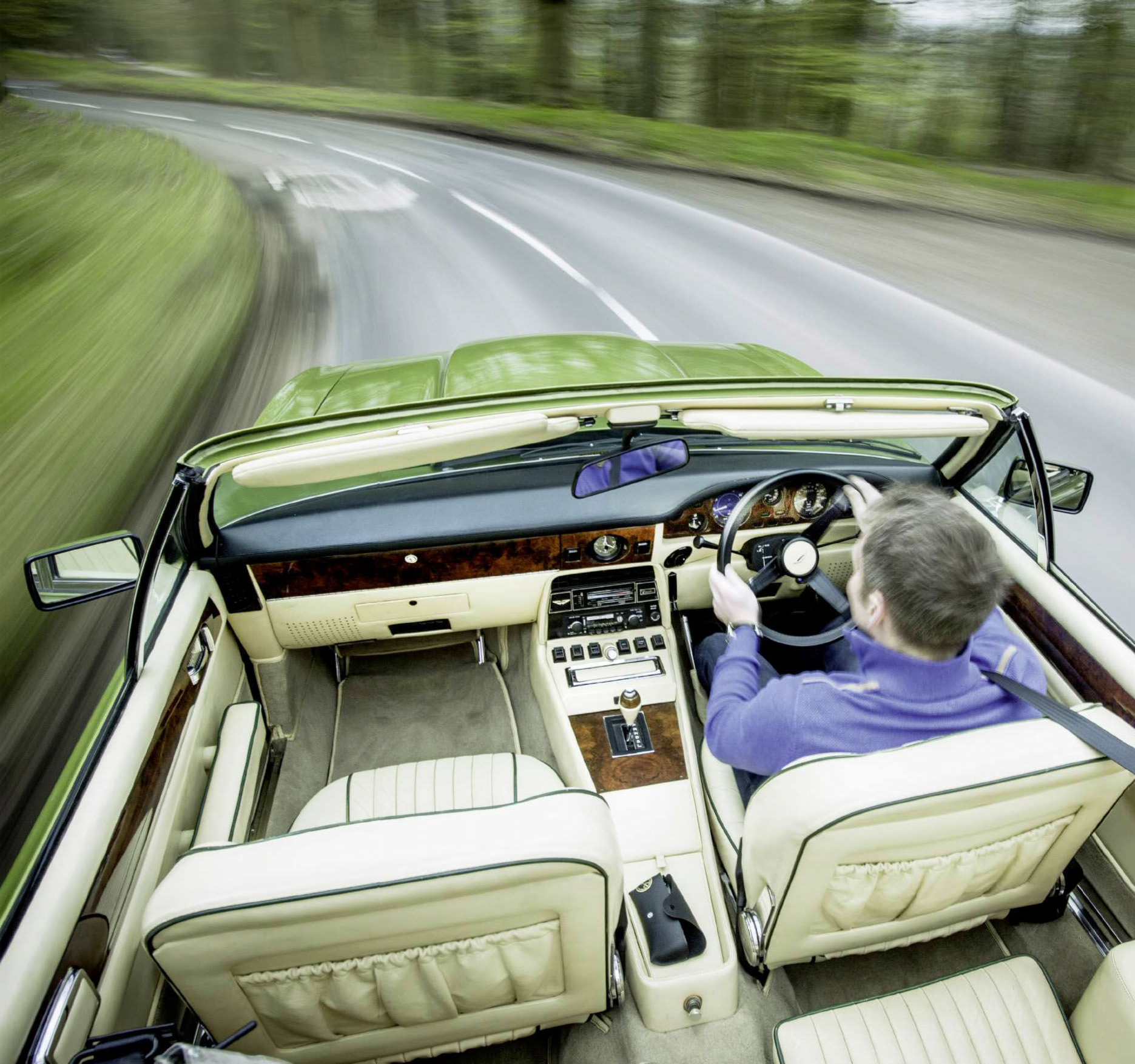
Occasional trips in an Aston Martin V8 Volante were a key influence on Tim Rogers’ childhood, but he never got behind the wheel – until now. Join him as he gets to cross one dream car of his wishlist. Words Sam Dawson. Photography Charlie Magee. Aston V8 Volante One lucky reader gets to drive the Aston Martin of his dreams. The List Reader Tim Rogers has fond memories of the Aston Martin V8 Volante he used to travel in as a child – now it’s his turn to tame this 305bhp ground-shaker.
The List
Aston Martin V8 Volante ‘I spent a lot of time in one of these as a child and was always in awe of its power and luxury’
Alfa Romeo 2000 GTV (105-series) ‘In fast-road trim, perfect for an early morning blast and the occasional track day’
Ferrari 365 GT4 ‘A distinctive design, daring and diferent. I’d have an automatic, in a colour other than red’
BMW M1 E26 ‘I used to watch them race in the Silverstone Six Hours in the Eighties; they looked stunning’
Porsche 911 ‘I’ve got great memories of driving through France in a 1977 2.7S – and I could have bought it for buttons…’
Tim Rogers is a surprise. I’d built up a picture in my head of a slightly unhinged biker arriving astride one of the glorious self-designed custom creations produced by his business, Spirit of the Seventies, and bemoaning the fact that the 1981 Aston Martin V8 Volante he was about to drive had an automatic gearbox rather than the rare, heavy-throw manual. Bikers tend to be like that, but when Rogers’ Porsche 996 gurgles to a halt outside Classicmobilia’s Buckinghamshire storage warehouse, he reveals a much more personal reason why he’s always wanted to take the Newport Pagnell land-yacht for a drive.
‘We all came from a humble background in Coventry,’ says Rogers, ‘but my dad’s best mate – who was the father of my best mate – had a double-glazing business that did very well, so he used to come round and pick us up in some amazing cars, but the best was his Aston Martin V8 Volante. I used to sit in my bedroom listening out for the sound of those town-and-country horns.
‘We went to Alton Towers in it once, and from my vantage point in the back seat I saw 135mph on the speedometer. And all the while his wife was sitting in the front passenger seat reading a book! When I went round to his house, we used to sneak into the garage and just sit in it, inhaling the aroma of the leather. It was magical.’
Oddly enough, though, he’s never been tempted to buy a big luxury car himself. ‘My first car was a 1980 Alfasud 1.3 Super – I bought it in 1988 just after I passed my test. I drove the wheels off that thing, but it dissolved within 12 months and I couldn’t afford to get it fixed, so I went out and got another one. You’ve got to bear in mind that I used to follow Gilles Villeneuve in Formula One, and Alfas were the closest that ordinary people could get to Ferraris.’
The restoration of a 1974 2000 Berlina duly followed, but with the exception of a brief TVR S2 foray, his recent cars have been Porsches – a 996 and 944. Even then, there’s still a connection to the Volante: ‘Porsches were an itch I had to scratch,’ says Rogers, ‘but it’s an itch I got watching Group C racing in the Eighties, and we’d go to those races in the Aston – it was all part of the experience for me.’

We settle into the expansive cabin swathed in biscuit-coloured leather, and as Tim adjusts the driver’s seat he remembers a detail from his childhood. ‘Does it have that footbrace in the passenger-side footwell?’ he asks. ‘I remember making use of that.’
The V8 chunters out of Classicmobilia’s converted farmyard, the huge 235/70 VR15 tyres easing their way over speed humps, and on to the narrow Buckinghamshire lanes in a meandering route towards Aston Clinton, the location of the hillclimb that the nascent Bamford- Martin factory team won in 1914, gifting the marque its new name. ‘It’s got incredibly light steering,’ Rogers remarks, ‘and that bonnet is just immense. It’s a car that feels epic in every way – both in its size and the kind of drives you’d take it on. The steering does weight up a lot mid-corner, so you can’t completely escape its sheer mass even if the power assistance is good, and that vast bonnet makes it easy to place on the road but also makes you realise how wide it is.’
Once accustomed to the Volante’s behaviour in corners, Rogers is back on his nostalgia trip. ‘I can almost smell his Slim Panatellas and see his Eagles tape on the centre console out of the corner of my eye. That’s what we’d listen to on those trips out in the Volante – the Eagles, Roxy Music, Dire Straits – in fact that’s the sort of thing I’d listen to if I owned it now as well. Along with some David Bowie, maybe.’
Rogers straightens his arms and relaxes as we move on to a highspeed stretch of dual carriageway, where the car feels much more at home than it did when threading its way between rural hedgerows. ‘I don’t want to sound disappointed when I say this – because I’m not, quite the opposite – but it kind of drives and rides exactly like I thought it would, as a gentleman’s express. You’re wafting along and there’s no aggression – it’s just like a massive, green deep-pile carpet with wheels. It’s a smooth car too; it doesn’t wobble and there’s not much scuttle shake for a big, open-topped car. I’m impressed with its lack of roll in high-speed bends. That doesn’t mean it corners like a sports car, but it’s incredibly composed and serene.’
There’s one unavoidable aspect of the car that bellows sporting intent, though. ‘The noise that V8 makes is fantastic,’ Rogers remarks, with a big grin on his face. ‘It’s an emotive, visceral, spine-tingling sound. It doesn’t bark like an Italian supercar, but it’s not a subdued rumble either. It’s a dignified growl, a constant reminder of how much power is available if you indulge your right foot. It’s like a thug in a sharp suit, patting a gun in his inside jacket pocket.’
As we pass the first signs for Aston Clinton, Rogers explains the reasons why something so refined can appeal to a biker. ‘Coming from bikes, you end up with a slightly different perspective on performance. There are cars out there that scare you witless with speed, but even they are nothing compared to an average sports bike. I used to be obsessed with 0-60 times; as a kid it was how I’d judge one car against another, but since I’ve ridden motorcycles I realise that performance is about being able to use that power on the road. This Aston tracks beautifully, so you can use its power in the right circumstances – even though I’m sure no potential owner would chuck it around.
‘It’s not even like a Jaguar, with that combination of sporting balance and high-end luxury. It’s more like a Rolls-Royce Corniche crossed with a Bentley Mulsanne Turbo – or the way I’d imagine them to be anyway. It’s that body-on-chassis heft, coupled with the way that you’re only really reminded of it when braking.’
And then, just before we turn off the dual carriageway, there’s an unexpected moment of comedy as Rogers flicks the indicator stalk and a springy tick-tock emerges from the dashboard’s innards. ‘Listen to that! I hear the sound of that indicator and suddenly it’s 1978 and I’m in my mum’s Morris 1300!’ But as he reflects on the humble parts that may be lurking behind the deep-pile gloss, Rogers’ mind analyses the Aston from another, slightly more melancholy angle.
‘You know what? I don’t feel like I belong in this car,’ he confesses. ‘It’s a class thing, I think. It’s part of the old order. We live in more egalitarian times nowadays, but it’s still “old British”, and if you aren’t part of its private-members-club world then driving it feels like you’ve wandered into someone else’s stately home. It’s a car for gravel driveways and great big mansions, or half-timbered Tudor houses.
‘Roger Moore drove one in The Persuaders, didn’t he? His character, Brett Sinclair – that’s exactly the kind of person who’d have driven this car when it was new. Then again, what with all this talk of class and tradition, it comes from a time when Aston Martin did the Lagonda, which was totally different and very new-money, which explains why so many of them ended up in the Middle East.
‘One thing this car does is to highlight how our ideas of refinement seem to have changed,’ notes Rogers. ‘I’m comparing it to my 996 – which is sportier, but still a GT – when you drive over a manhole cover.
In this Aston, not one bit of that surface change is transmitted through to the cabin. However,’ (he points at the gearlever jiggling audibly against its wood-and-chrome housing) ‘it annoys me that modern car companies end up completely ignoring things like ride comfort, yet get so hung up about eliminating little things like that rattle, and still call it refinement. What’s sold to us as progress hasn’t always made things better.’
The roads are narrowing appreciably now, creeping up in altitude, and the hedgerows are closing in on us. We see the innocuous sign for Aston Hill coming up on the left, and Rogers prepares to propel the Volante out of its comfort zone by pitching it up the bounding corkscrew of woodland road on which Lionel Martin’s Singer-based sports special powered to victory on April 4, 1914.
‘I’m going to have to think, to plan ahead more,’ says Rogers tersely. ‘That said, after the first five minutes of being intimidated by the car, now I’m acquainted and much more relaxed about driving it. The braking process takes a little longer than I’d originally thought, but it’s not a bad system overall. You have to make more of your own input into the drive – you can’t get into that lazy, modern, just-flick-a-switch-and- everything-works mindset of driving. I’m sure modern Astons are amazing, but I bet they pander to that too.’
Rogers is silent as he negotiates the hillclimb course. The surface is tarmac nowadays, but the narrow ascent with its corners blinded by trees and hedges is daunting in such a wide car.
He soon learns to allow the suspension to breathe from bend to bend, pressing and lifting the throttle with the road’s undulations. ‘I remember Dad’s four-speed Morris Ital struggling on roads like these in 1981,’ Rogers remembers. ‘By contrast, this is like a spaceship. The contrast in abilities on ordinary roads between contemporary cars back then was like suddenly switching from black-and-white television to colour.’
As we thunder to a halt besides the Aston Martin Memorial at the brow of the hill, sitting among long grass and looking forlornly like an unattended grave, Rogers ponders the excitement of the era that gave birth to the Volante. ‘The Sixties and Seventies were decades of incredible progress,’ he says. ‘Nowadays it seems like there’s a lot of progress just for the sake of it – I’m talking about electronic handbrake buttons and the like – and people don’t appreciate it. When you think about other breakthroughs that were made at the time, like Concorde and the Lamborghini Miura, you’ve got to wonder whether real progress began to peak around then.
‘I certainly think it came to an end with the rise of the hot hatch, with widespread fuel injection in the late Eighties,’ says Rogers. ‘Nowadays even the most humble supermini drives like a hot hatch. Nothing’s out of its depth anywhere, and that’s made the modern equivalent of cars like this less special, somehow. This is a product of that last great gasp of analogue progress.’
Rogers pulls on the hefty chrome lever to release the enormous bonnet and gets out to admire the 5.3-litre V8 that propelled the Volante up the hill, and instantly a little plaque on the block catches his eye. ‘‘Engine built by Bert Nash” – I love that. Good old Bert. I can picture him now, in a flat cap and store coat, with decades of experience behind him. It’s reassuring rather than pretentious.
‘And look at the size of that torque converter! Then again, there’s a lot of torque to convert. It’s funny – my 996 is a Tiptronic, and likewise I don’t feel this Aston loses anything by having an automatic gearbox. Purists may protest, but somehow the car suits this transmission. Had you asked me as a teenager in the Eighties, I’d have said any proper performance car should always have a manual gearbox, but now I appreciate that’s not what this car’s about.’
We climb back in, raising the canvas roof against a few tiny droplets of rain that have started to dampen our spirits for the drive, and head back down the hill. I’m about to ask Rogers whether he still wants to own the car he once coveted from the back seat, when something happens that answers it all for me.
Coming up the hill in the opposite direction, we spot the pinprick sidelights and compact tautness of a brand-new Aston Martin V8 Vantage. Upon seeing its ancestor barrelling down the hillside that made the marque, the driver flashes the headlights, waves at us and beams a warm grin, slowing down slightly to admire the flow of the Volante’s flanks. Rogers waves back, and continues to smile wistfully.
‘He probably thinks it’s mine,’ he muses. ‘I may as well enjoy that feeling while it lasts.’
THE IMPORTANT MODELS
1969 DBS V8 The car designed to house Aston’s new engine was released two years before the motor was ready, but DBS and V8 were united in 1969, creating the car otherwise known as the V8 Series 1. The fuel-injected engine made 315bhp.
1972 AMV8 Retrospectively referred to as the Series 2, this makeover saw a new grille flanked by single headlamps, and a name to end the DB line. The old six-cylinder engine was also offered in the new body as the entry-level AM Vantage.
1973 V8 As Aston Martin teetered on the edge of bankruptcy, the troublesome Bosch fuel injection was dropped and the trusty Weber carburettors made a comeback for the Series 3. Power suffered, falling to 288bhp
1977 V8 VANTAGE New Aston co-owner George Minden’s personal high-performance version, facelifted with blanking plates over the bonnet scoop and grille and a new bootlid spoiler, had a 380bhp V8 fed by downdraught carburettors – a production model to rival Italian supercars.
1978 V8 VOLANTE & ‘OSCAR INDIA’ Co-owner Alan Curtis’ convertible version, initially for export only, unveiled at the 1978 Pebble Beach concours – it won its class, launching it into the American market. Integrated rear spoiler and loss of bonnet air intake were coded ‘OI’.
1986 V8 EFI A much more reliable electronic fuel injection system from Weber-Marelli makes a return after 13 years, and the car loses its bonnet bulge as a result. The V8 remains on sale for another three years, and in 1989 Aston Martin Lagonda Ltd posts its first-ever profit.

It’s a car with personal memories and symbolic of ‘the last gasp of analogue progress’ for Tim. The 5.3-litre V8 (and its engine builder’s plaque) delighted Tim.
‘The noise it makes is fantastic. It’s a dignified growl, a reminder of how much power is available’

After stepping out of a 996, the sheer width and mass of the Aston take some acclimatisation.
‘That bonnet is just immense. It’s a car that feels epic in every way’
TECHNICAL DATA 1981 Aston Martin V8 Volante
Engine 5340cc V8, dohc per bank, four Weber 42DCNF carburettors
Power and torque 305bhp @ 5000rpm; 320lb ft @ 3000rpm
Transmission Four-speed automatic rear-wheel drive
Steering Power-assisted rack and pinion
Suspension Front: independent, wishbones, coil springs, telescopic dampers, anti-roll bar. Rear; live axle with Watt’s linkage, trailing arms, cod springs, telescopic dampers
Brakes Discs front and rear (inboard rear)
Weight 1814kg (3999lb)
Performance 0-60mph: 8.9sec; top speed: 149mph
Fuel consumption 13mpg
Cost new £42,499
Values now £54,000 £115,000





